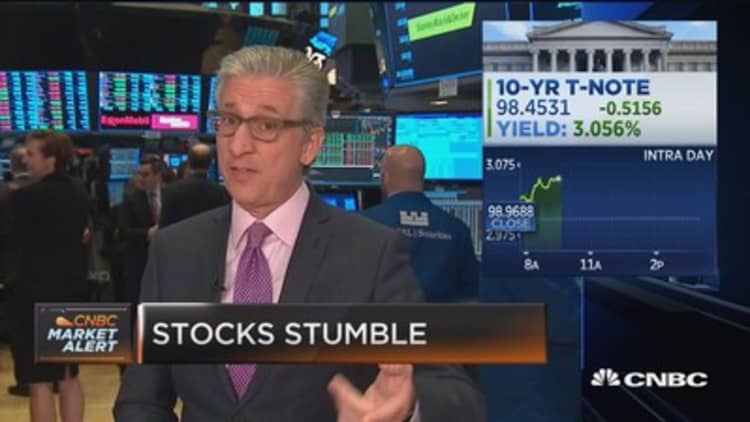
The yield on the benchmark 10-year Treasury note hit its highest level since 2011 and the two-year yield hit its highest mark since 2008 after strong retail sales and manufacturing data.
The 10-year Treasury note, which moves inversely to price, rose 9 basis points to 3.091 percent Tuesday, north of the 3.03 percent clinched in late April and the highest since 2011. The two-year yield hit a high of 2.589 percent, its highest level since August 11, 2008.
The 10-year yield is especially important to investors given its role as a barometer for mortgage rates and other financial instruments.
The yield on the 30-year Treasury bond was also higher at 3.22 percent, its highest since April 26.
"There are a number of fundamental issues to watch and as long as economic growth remains steady, then the call for the Fed to keep raising rates will stay loud," wrote Kevin Giddis, head of fixed income capital markets at Raymond James.
"On top of that, the Treasury will need to keep coming and coming with larger auctions throughout the year to pay for not only the 'tax sweepstakes,' but to continue to keep up with the ambitious growth plan coming from the White House," he added.
The Commerce Department said retail sales increased 0.3 percent in April, while March's figure was revised up to a 0.8 percent gain. The spending gains were spread broadly across the retail industry, with big gains at furniture and clothing stores.
The New York Empire State Index, a gauge of manufacturing in the region, came in at 20.1 for May, much better than the 15 level estimated by economists.
The rise in yields knocked stocks, which opened lower Tuesday.
Investors are betting the Federal Reserve will keep its aggressive stance even if it unnerves financial markets a bit. Traders for the first time Monday assigned a 51 percent chance of a fourth interest rate hike this year by the Fed, according to the CME. The strong data Tuesday will only increase the ranks of traders and investors with that belief.
"This is continuing to be a quintessential Goldilocks kind of economy and Goldilocks expansion: The economy's growing at a solid pace," said Nathan Sheets, chief economist at PGIM Fixed Income. "This is the kind of economy central banks dream of, not too hot, and not too cold."
Yields have been on the move higher this month ever since the Fed said on May 2nd that inflation was moving closer to its 2 percent target. The Fed next meets on June 12.
Rising inflation is a threat to Treasury prices because it erodes the purchasing power of their fixed payments, putting upward pressure on rates.
"I think it's important to get above 3 percent and show some upward momentum," said Michael Schumacher, director of rates strategy at Wells Fargo. "I'm not hung up on whether its 3.03 , 3.04, or 3.05 but it's a pretty sizeable move and that's important."
Treasurys
The latest uptick in rates also comes amid a rally in oil prices, a phenomenon that could have ripple effects throughout the economy and raise input costs across several sectors.
In oil markets, Brent crude traded at around $78.45 a barrel on Tuesday morning, up by 0.2 percent, while U.S. crude was around $70.93 a barrel, off by 0.08 percent. Oil prices held firm as market players saw signs of ongoing strong demand for the commodity.
An OPEC report Monday showed that oil inventories in Organization for Economic Co-operation and Development (OECD) nations dropped to 9 million barrels in March, above the five-year average.
— With reporting by Patti Domm



